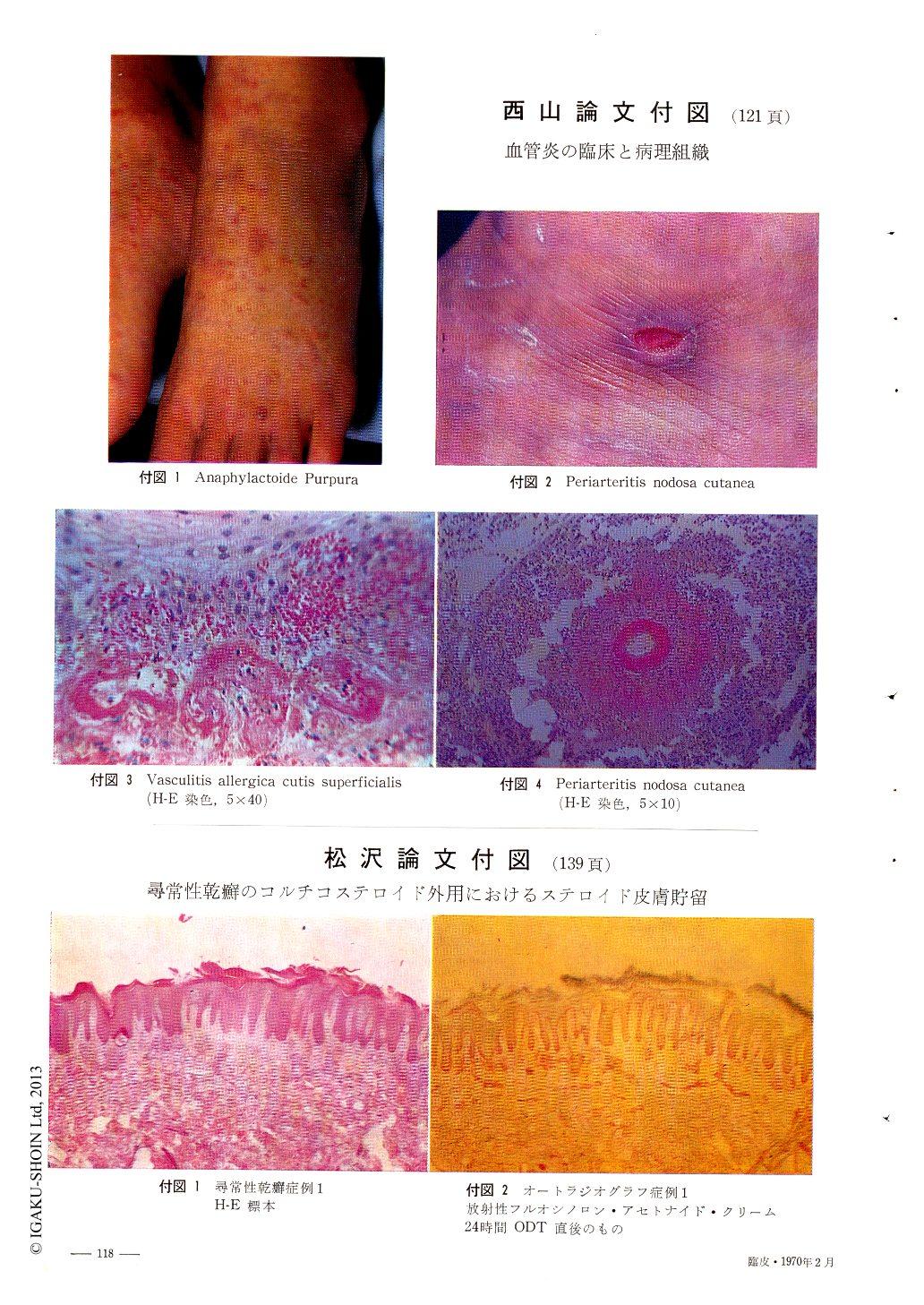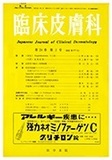Japanese
English
- 有料閲覧
- Abstract 文献概要
- 1ページ目 Look Inside
はじめに
閉鎖包帯法(ODT法)にて外用されたコルチコステロイドの正常皮膚での貯留現象は近年よく知られている。Malkinson, Ferguson1)(1955)は,正常人皮膚に放射性ハイドロコーチゾン軟膏を外用し,1957年には2),皮膚病患者に放射性コーチゾン軟膏を外用して,その後尿中17—KS分画中の放射能を測定する方法を用い,放射性軟膏塗布後尿中に6日間にわたつて放射能の排泄を認め,このことから外用されたコーチゾンおよびハイドロコーチゾンがいつたん皮膚に貯留し,その後徐々に体内に吸収されていくことを推測した。おそらくこれがコルチコステロイドの皮膚貯留を推測した最初の報告である。Vickers3)(1963)は毛細血管収縮試験を指標に用いてトリアムシノロン・アセトナイドの皮膚吸収および皮膚貯留現象の実験をおこない,外用されたトリアムシノロン・アセトナイドが,皮膚の角質層に沈着しそれが2週間にわたつて貯留することを証明した。この現象をコルチコステロイドの皮膚吸収の指標に用いる事を推奨したのは,McKenzie, Stoughton4)(1962),McKenzie5)(1962)などである。Stoug-hton6)(1965)は,正常皮膚に各種の放射性コルチコステロイドを外用した後その部分の角質層をスコツチテープを用いて剥離し,その剥離された角質層中の放射能を測定する方法を用いて角質層に放射性コルチコステロイドが沈着しているのを証明し,コルチコステロイドの沈着部位は皮膚の角質層であるとした。Carr, Wieland7)(1966)は放射性トリアムシノロン・アセトナイドの溶液を正常皮膚に外用した後,スコツチテープにてその部分の角質層を剥離し,剥がれた角質層中の放射能を測定する方法を用い,角質層内にコルチコステロイドが沈着することを証明した。Kligman8)(1967)は,クロトン油皮膚炎試験を指標に用いて閉鎖包帯法(ODT法)にて外用されたフルオシノロン・アセトナイドが皮膚に貯留し,抗炎症作用を発揮して何日間クロトン油皮膚炎に拮抗するかを測定し,フルオシノロン・アセトナイドで1回の24時間ODTをおこなつた場合その抗炎症作用は8日間にわたつて残存し,クロトン油皮膚炎を発生させないことを示した。このことはフルオシノロン・アセトナイドの皮膚貯留が,少くとも8日間は存在するということを示しているものであろう。
以上はほとんどが正常皮膚における外用コルチコステロイドの皮膚貯留に関する報告であるが,一方Vickers9)(1966)およびScoggins10)(1963)の見解によれば,尋常性乾癬においては外用コルチコステロイドの皮膚貯留がおこらないとされている。
Radioautographic studies on the retention of corticosteroid in the skin after topical application to the lesion of psoriasis vulgaris were performed.
Fluocinolone acetonide cream which was labeled with C14 in the acetonide base, was applied for 24 hours by ODT on the psoriatic lesion. Immediately after the application of 24 hours' ODT, markedly increased radioactivity was proved in the horny and malpighian layers of the epider-mis. The margin was markedly defined between the basal layer and the dermis. This finding suggested that the second barrier against the skin absorption might exist at the basal layer of the epidermis.
Autoradiogram, 3 days after suspension of topical application of ODT, showed that radioacti-vity was found slightly in the epidermis and hair follicles.
Seven days after the suspension, no radioactivity was proved in one case, but trace of it was proved especially on the superficial malpighian layer in another case with mild change histologically.
The findings suggested that there might be the retention of the steroid in the lesion of psoriasis vulgaris. But the retention time was a little shorter than normal skin. It might have some correlation with accelerated turnover time of the psoriatic epidermis.

Copyright © 1970, Igaku-Shoin Ltd. All rights reserved.


